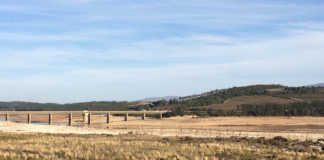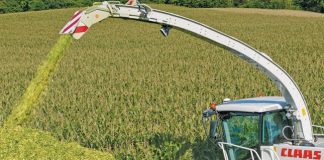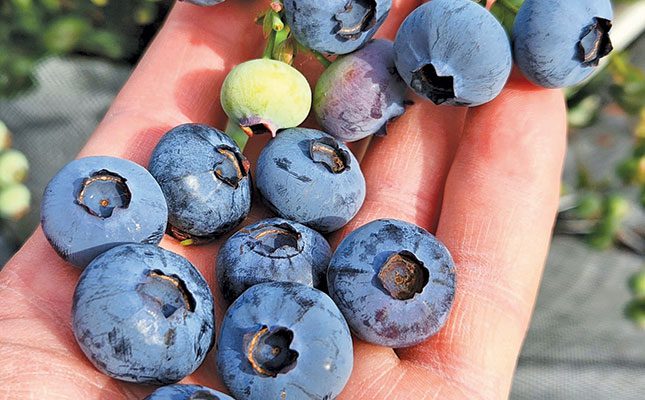
Photo: Supplied
According to Pieter Zietsman, berry manager at TopFruit South Africa, a company that develops and markets licensed or club fruit varieties, blueberries are on the up with 15% year-on-year growth in berry hectares planted and fruit sold worldwide.
“This is very significant,” he says. “By comparison, the worldwide apple industry grows by around 2,5% to 3% annually.
READ The complexity of berry production
Another significant blueberry-industry shift, he says, is in the relaxing of cultivar and marketing options across the board.
“TopFruit has a number of cultivars available and many, upwards of 12, marketing options, so growers are not tied in either in terms of what they plant or what price they achieve.”
He says that critical grower questions must include the cultivar selection and especially a focus on when bushes come into fruition.
“The earlier to market, the better,” he says, adding that the South African growers’ harvests peak typically three weeks earlier than in Peru, South Africa’s biggest blueberry competitor, and Western Cape-grown varieties might trail up to six weeks behind those grown in South Africa’s north, which is why variety selection is very important.
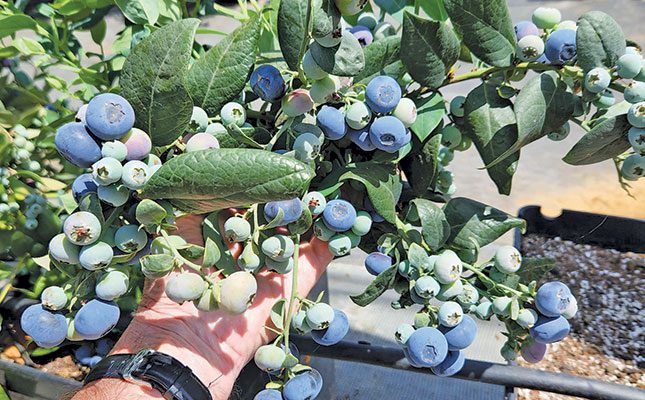
“Berries require acidic soils of a pH of six or less and a sandy soil type with less than 30% clay and silt. So, if growing conditions are not ideal, planting in pots is a good idea while planting in tunnels has other benefits. If hail and frost damage is a risk, nets and fans may have to be used.”
Zietsman says there is a potential South African blueberry market for 15 000ha over the next 20 years, and currently 80% of TopFruit’s berry plant orders are to replace berry varieties with better-performing, open-access varieties.
He says that 15t to 20t of fruit can be expected per hectare after the third leaf.
“Berries require chilling down to 6°C, starting within at least two hours of picking, to maintain optimum quality, and can be stored at -0,5°C for up to six weeks from harvest during sea freight,” he says.
Choosing the right varieties
According to Zietsman, the Standard Southern Highbush variety is mostly planted in South Africa and doesn’t require as many cold units as Northern Highbush and rabbit-eye varieties.
“TopFruit’s selection comes from the University of Georgia (low-medium-chill floricane types), IQ Berries (very low-chill primocane types) and New Zealand varieties (rabbit-eyes),” he says.
South Africa currently exports about 90% of its berries and has the shortest route from the Southern Hemisphere to markets in the UK and Europe.
READ Profiting from apples: why quality trumps yield
Zietsman says that South Africa mostly grows low-chill varieties and while, historically, berries have been packed into 125g punnets, an increase in the number of 300g and 600g package options have come to market.
He says that TopFruit also sees potential additional growth from the loosening of ‘closed-variety’ agreements.
Justin Mudge of Chiltern Farms in the Western Cape’s Vyeboom region says they have reduced blueberry plantings to 55ha as they are no longer growing the ‘non-desirable’ varieties.
“This is not ideal and has provided some challenges for management. We are now down to eight berry varieties with further reductions still to be made.
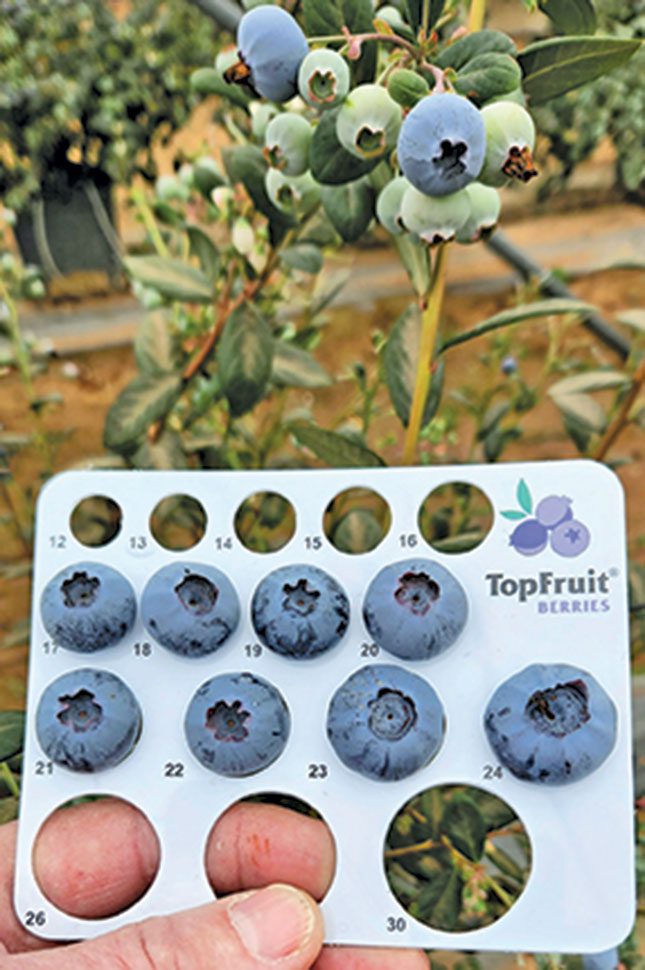
I would say that this is one of the biggest lessons that has been learnt in the last few years: not all varieties will perform equally well in all regions.
“I personally think it is time for variety owners and licence holders to be more transparent with the results achieved in the various regions. Producers need the best possible opportunity to make a successful investment decision as there are so many other variables that we cannot control. At Chiltern Farms we’ll be very intentional in how we select genetic material if we continue to invest in berry farming,” says Mudge.
He adds that blueberries are an intensive crop that requires a high level of precision farming.
“Fertigation is one of those inputs. We try to be as accurate as possible to provide what the plants need when they need it, and ensure that we measure as much as possible to gain insight into the success of these treatments.
Each variety is different and it is critical that you irrigate/fertigate to the varieties’ requirements. This requires a higher investment into the establishment of orchards, but we believe that if you invest wisely in the establishment, you will ultimately reap the rewards.
READ Optimal irrigation for perfect blueberries
“We have focused on growing berries that we can actually harvest well by removing berries from the inside of the bush growing on weaker wood. We have also invested in our cold chain and put a lot of focus on getting the berries into post-harvest cooling within an hour from picking.”
Mudge says that it may, perhaps, be a little early to make any conclusions pertaining to marketing agreements.
“Changes were made to assist with market development and to extend reach into new customers in new territories. Berryworld SA and their variety partners have been very successful in bringing world-leading berry genetics to South Africa and have, from a technical point of view, ensured that these genetics can deliver good yields of high-quality berries.
This has created a steep increase in the volume available for export which, in turn, concentrated a lot of volume through a single channel.
When one couples this with the challenges that have been faced in the three previous seasons, a situation occurs where there just isn’t enough optionality to move the fruit at the required returns.
So, evolution is required to ensure that producers have access to a wider range of markets and customers work with competitive supply chains so that we can make sustainable returns to the orchard.
We have seen that direct contact with the market has given us the ability to make better decisions before we even pick the fruit, and this, hopefully, will yield better results when the supply-demand situation changes,” says Mudge.
Stiff competition
Marcus Rosochacki of Rosoberry at Hermanus River Farm in the Western Cape’s Overberg was for five years nursery manager for Vitroplant SA, a plant biotechnology company, where he developed a passion for berries.
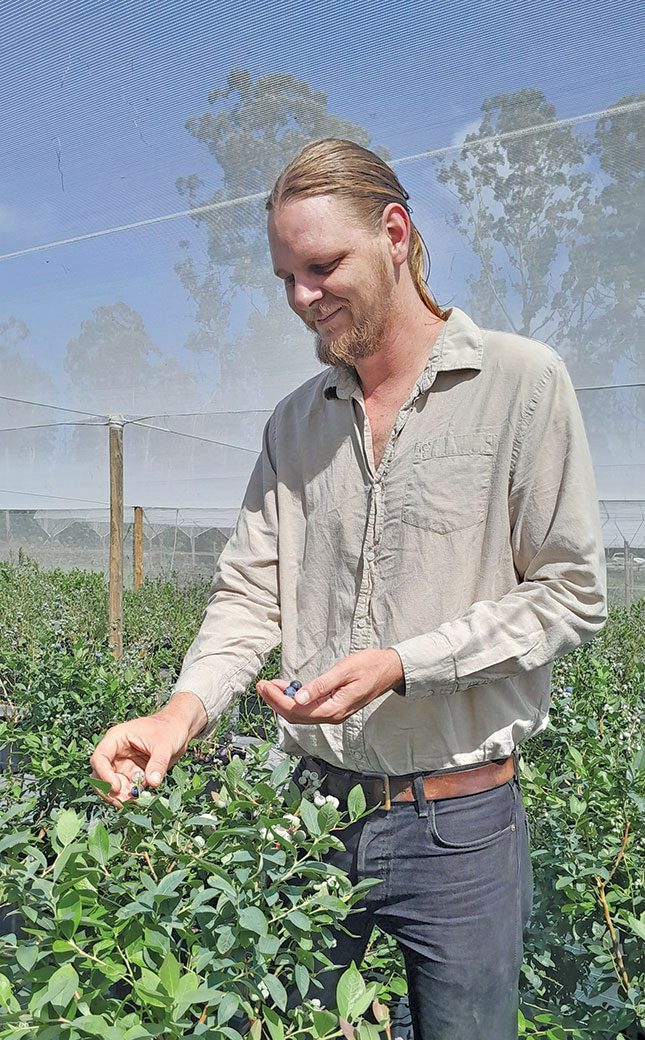
“The blueberry industry in South Africa has grown rapidly but more berry sales in the country does not mean more profitability for the farmer. Each growing area has its own unique challenges down to each hill or valley.
Very few varieties show reliable resilience and adaptability to many growing regions.
Varieties are often prescribed based on basic climate data, and a farmer may be encouraged to plant many varieties.
This, typically, leads to the discovery that many or most of the varieties prescribed to them do not work in their context. This then results in enormous loss of revenue in some portion of the operation, which dramatically reduces the potential for profit.
“Farmers may be left questioning why they pay royalties for several varieties when only one or two work as well as they hoped. Thus farmers seek to rectify this by reducing royalties, or increasing freedoms in their marketing agreements,” he says, adding that the fact is that licensed varieties from reputable breeding programmes are far superior to older, unlicensed varieties, and in the right context, with the right trialing (by the farmer or the variety manager), these licensed varieties produce exceptional fruit and their royalties are reasonable.”
Rosochacki warns that farmers and investors chase the dream of big money only to discover that many school fees need to be paid to achieve this goal.
“The industry is feeling its growing pains, and those without patience to trial varieties and practices, or those without deep pockets are really hurting. One cannot ignore the global competition and in particular the rapid expansion of Zimbabwean production as compounding stressors. Farmers can no longer hope to ‘get in on the boom’, but rather need to face the reality that this is a new luxury commodity with stiff competition,” he says.
READ A guide to optimising blueberry production
According to Rosochacki, the time and resources laid out by breeders and licence managers is substantial and they need a reliable model to draw their income.
The model of obtaining plant breeders’ rights, and extracting royalties under the protection of stringent contracts and laws, is a boon for the agriculture industry globally.
“For the health of the industry, these restrictions should not be relaxed. Farmers have burned their fingers on untested or inadequately tested varieties. They should rather do more research before committing to reasonable but tough agreements. There are many models of plant breeders rights’ management, and farmers are free to engage with different companies with different models that may suit their needs.”
From a production perspective, he says broadly that he’d recommend using shade nets, dripper irrigation, and large pots (30ℓ to 40ℓ rather than 25ℓ). As for varieties, there are, he says, many great ones.
“In my block I will only make special mention of Maverick and Miss Jackie, managed by TopFruit. Whilst they may produce berries in a marketing window that is suboptimal, the fruit is exceptional and they are vigorous plants with little trouble handling the pest and disease pressures in my area of the Overstrand,” he says.
Justin Burls of Peregrine Farm Stall in Grabouw, who sells Rosoberries, says they are grown in tunnels in a valley.
“Some farmers have been heavily affected by high input costs and logistical challenges, particularly at our ports. Local demand, however, remains strong, with 6t being sold from a table on the stoep at Peregrine Farm Stall in the previous blueberry season between December and March. Locals enjoyed interacting and buying the fruit directly from the farmer at R90/kg. And the fruit was generally picked the day before selling, so it could not be fresher.”
The Shoprite Group told Farmer’s Weekly that the demand for premium-quality berries at affordable supermarket prices had increased significantly at Checkers supermarkets over the past three years.
“Since 2020, the berry category has enjoyed notable growth compared with other fruit categories,” Shoprite Group said.
Vito Polera, national head of fresh produce buying for the Food Lover’s Market Group, says: “We source cherries from Ceres and the Free State when in season. Blueberries are locally sourced from all over South Africa. In our fruit category, blueberries and cherries sell well in their season; they’re especially popular during our promotional campaigns. The Food Lover’s Market’s range of cherries, Cheeky Cherries, does especially well over the festive season.”









